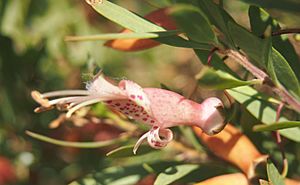Spotted emu bush facts for kids
Quick facts for kids Spotted emu bush |
|
|---|---|
 |
|
| Eremophila maculata subsp. maculata leaves and flowers | |
| Scientific classification | |
| Genus: |
Eremophila (plant)
|
| Species: |
maculata
|
The Eremophila maculata, also known as the spotted emu bush or spotted fuchsia-bush, is a plant that belongs to the figwort family. This plant is special because it is found only in Australia. It is the most common type of Eremophila plant found in nature and is also very popular to grow in gardens. It is a bushy plant that spreads out, and its leaves and flower colors can be different. However, the size and shape of its flower parts are always the same. The inside of its flowers often has spots, but not always.
Contents
What it Looks Like
The spotted emu bush is a low, spreading shrub. It usually grows to be less than 2.5 meters (about 8 feet) tall. Its leaves can be tiny, about 3.8 millimeters (0.15 inches) long, or much longer, up to 45 millimeters (1.8 inches). They can also be very thin or almost round. The leaves are almost always smooth, without any hairs, and their edges are always smooth, without any teeth.
The flowers come in many colors, even on the same plant! You might see pink, purple, red, orange, or yellow flowers. The inside of the flowers often has spots. Each flower grows by itself where a leaf meets the stem. It has a smooth, S-shaped stem that is 10 to 25 millimeters (0.4 to 1 inch) long. There are five green or purplish-green sepals, which are like small leaves that protect the flower bud. These sepals are egg-shaped and end in a sharp point.
The five petals are joined together to form a tube that is 25 to 35 millimeters (1 to 1.4 inches) long. The parts of the petals on the sides and bottom of the flower often curl back. The outside of the petals is smooth, but the inside of the tube is hairy. There are four stamens, which are the parts that make pollen, and they stick out beyond the petals. You can see flowers almost any time of year, but they are most common in winter and spring. After the flowers, the plant makes dry, round fruits that have a clear beak-like shape.
Naming the Plant
The spotted emu bush was given its current name, Eremophila maculata, in 1859 by Ferdinand von Mueller. Before that, in 1822, it was first described by John Bellenden Ker Gawler as Stenochilus maculatus.
The word maculata in its name means "spotted." This refers to the clear spots often seen on its flowers.
Scientists have found three main types, or subspecies, of Eremophila maculata:
- Eremophila maculata subsp. brevifolia: This type has leaves that are egg-shaped or almost round and are wider than 2 millimeters (0.08 inches). The name brevifolia means "short leaves."
- Eremophila maculata subsp. filifolia: This type has very thin leaves, less than 2 millimeters (0.08 inches) wide. The name filifolia means "thread-like leaves."
- Eremophila maculata subsp. maculata: This is the most common type. It has leaves that are long and narrow, or shaped like a spear, and are wider than 2 millimeters (0.08 inches).
Where it Grows
The spotted emu bush grows in many parts of Australia. You can find it in Western Australia, South Australia, the Northern Territory, Queensland, New South Wales, and Victoria. It often grows in flat areas near rivers or in places that sometimes flood.
Plant Safety for Animals
In 1889, a book called 'The Useful Native Plants of Australia’ mentioned that some people thought this plant was harmful to animals, while others thought it was good food. It seems that animals used to eating it are usually fine. However, for animals that are not used to it, especially those traveling, it might make them sick. The plant seems to be more likely to cause problems after rain, and it is most risky when it has fruit.
Growing it in Gardens
The spotted emu bush is very popular for growing in gardens. There are even special types and mixes, like 'Carmine Star' and 'Aurea', that have been created. The most common type you see in gardens has cherry-colored flowers. It is easy to grow new plants from small cuttings taken from the tips of the branches during warmer months.
In nature, this plant often grows in heavy clay soil. In a garden, it can grow well in similar soil or even in deep sand. It likes a sunny spot that is protected from strong winds. This shrub is very good at handling dry weather and frost. It can also grow in areas near the coast that sometimes have high humidity. It is a good choice for gardens in hot, dry places like Arizona and New Mexico in the United States.
Images for kids
-
E. maculata subsp. brevifolia growing near Bromus Dam south of Norseman



